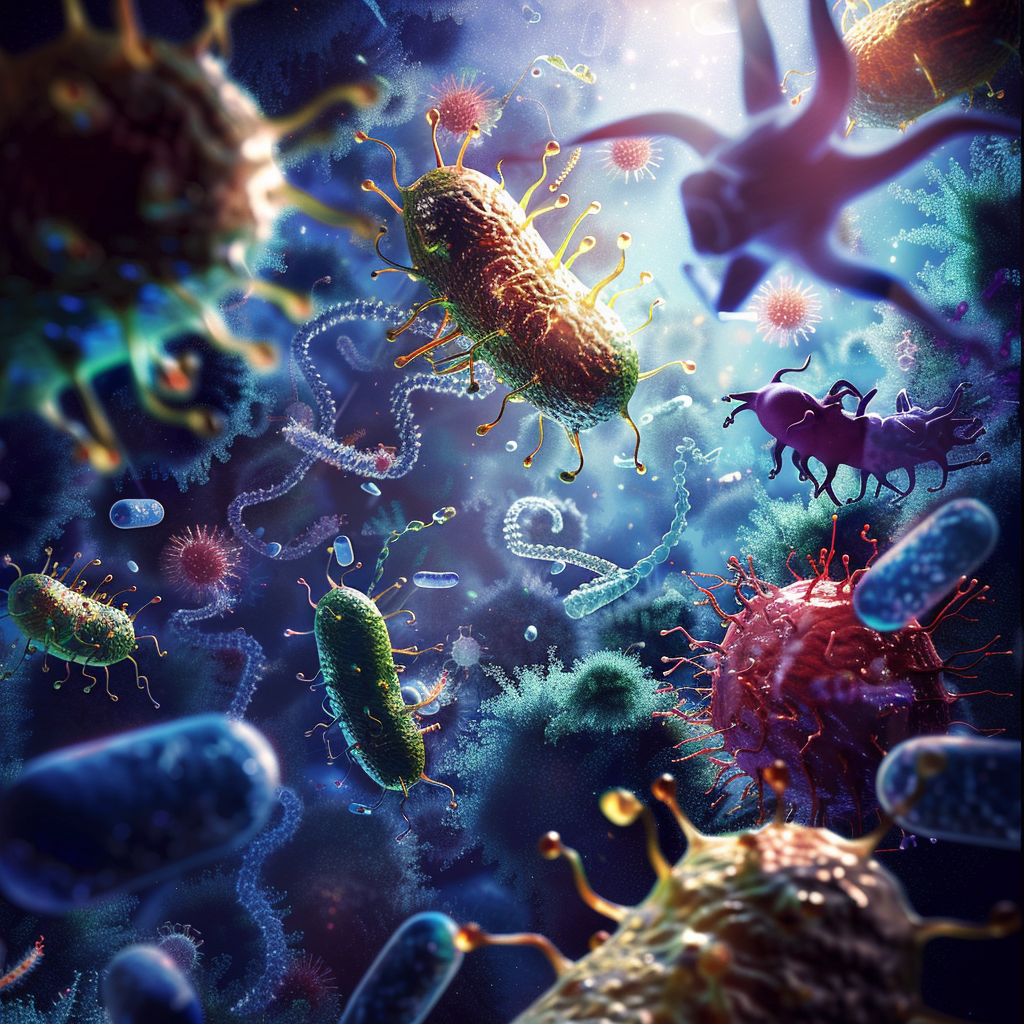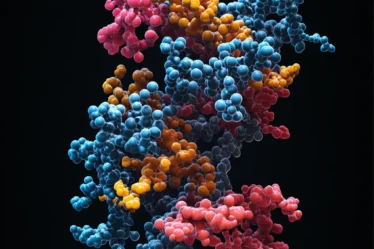
Prokaryotes are single-celled organisms without a nucleus. Their name comes from the Greek words “before nucleus,” indicating their simple structure compared to more complex cells. Prokaryotes include bacteria and archaea, which we find in almost every environment on Earth.
Prokaryotes are everywhere. They live in soil, water, air, and even inside your body. In fact, there are more bacterial cells in your body than human cells. These organisms are essential in processes like digestion, nitrogen fixation in plants, and decomposition of organic matter. They can survive in extreme conditions, such as hot springs and salty lakes, making them incredibly adaptable and vital to life on Earth.
Essentials of Prokaryotes and the Prokaryotic Cell
In a hurry? Don’t worry. Our quick takeaways on prokaryotes and the prokaryotic cell will give you a quick and easy summary of the main points:
🟠 Prokaryotes are single-celled organisms without a nucleus, found in almost every environment on Earth.
🟠 Bacteria and Archaea are the two domains of prokaryotes, with bacteria being more common and archaea often living in extreme conditions.
🟠 Binary fission is the primary method of prokaryotic reproduction, where a single cell divides into two identical daughter cells.
🟠 Horizontal gene transfer mechanisms, such as transduction, conjugation, and transformation, allow prokaryotes to exchange genetic material.
🟠 Biofilms and quorum sensing enable prokaryotes to form structured communities and communicate to coordinate collective behaviors.
Do you need help with the prokaryotic cell? That’s okay! Personalized tutoring or interactive biology classes can help you better understand these topics. Explore more biology topics and expand your knowledge with our free Biology blogs.
Classification of Prokaryotes
We classify prokaryotes into two main domains: Bacteria and Archaea. This classification highlights the significant differences between these groups despite their similar simple structures. Each domain has unique characteristics and plays distinct roles in various environments.
Two-Domain System: Bacteria and Archaea
Scientists classify prokaryotes into two domains: Bacteria and Archaea. This system helps in understanding their evolutionary relationships and distinct characteristics. Bacteria are more common and found in diverse environments, while Archaea often thrive in extreme conditions.
Overview of Bacteria
Bacteria are the most well-known prokaryotes. They come in various shapes, like rods, spheres, and spirals. Bacteria are incredibly versatile, found in soil, water, and even inside living organisms. They are essential for decomposition and nitrogen fixation; some can cause diseases.
Overview of Archaea
Archaea are less known but equally fascinating. They often live in extreme environments like hot springs, salty lakes, and deep-sea vents. Unlike bacteria, archaea have unique cell membrane lipids and can perform unusual metabolic processes, like producing methane. They help us understand life’s adaptability to extreme conditions.
Are you curious about evolution? Darwin’s theory of natural selection explains how species evolve based on traits that help them survive and reproduce.
Structure of Prokaryotic Cells
Though simple in structure, prokaryotic cells possess unique components that enable them to thrive in diverse environments. Understanding these structures helps explain their functions and adaptability.
Prokaryotic Cell Membrane and Cell Wall
Composition and Function of the Cell Membrane
The prokaryotic cell membrane, composed mainly of phospholipids and proteins, is a crucial barrier surrounding the cell. It regulates the movement of substances in and out of the cell, maintaining the internal environment and supporting various cellular processes.
Characteristics of the Cell Wall in Prokaryotes
The cell wall provides structural support and protection. In bacteria, it is primarily made of peptidoglycan, a polymer that offers rigidity. This wall helps maintain the cell’s shape and prevents it from bursting in hypotonic environments. The cell wall composition in archaea varies but lacks peptidoglycan, so other polymers are used instead.
Cytoplasm and Nucleoid
Role of Cytoplasm in Prokaryotic Cells
The cytoplasm is a gel-like substance inside the cell membrane. It mainly consists of water, enzymes, nutrients, and waste products. The cytoplasm is the site of many metabolic activities and contains all the cell’s internal components except the nucleoid.
Description of the Nucleoid
The nucleoid is the region within the cytoplasm where the prokaryote’s genetic material, typically a single circular DNA molecule, is located. Unlike eukaryotic cells, prokaryotes lack a membrane-bound nucleus. The nucleoid is essential for controlling the cell’s activities and reproduction.
Ribosomes and Plasmids
Function of Ribosomes in Protein Synthesis
Ribosomes are the molecular machines responsible for protein synthesis. In prokaryotes, ribosomes are smaller than eukaryotes but perform the same fundamental task of translating genetic information into proteins, which are vital for various cellular functions.
Importance of Plasmids in Genetic Diversity
Plasmids are small, circular DNA molecules found in prokaryotes, separate from the chromosomal DNA. They often carry genes that provide advantages, such as antibiotic resistance. Plasmids can be transferred between cells, promoting genetic diversity and adaptability in changing environments.
Why should you study microbiology? Find out what you’ll be learning.
Morphology of Prokaryotic Cells
Prokaryotic cells come in various shapes, each adapted to its environment and lifestyle. These shapes help identify and classify different types of bacteria.
Shapes of Prokaryotic Cells
- Cocci: Spherical or oval-shaped cells. Examples are Streptococcus and Staphylococcus.
- Bacilli: Rod-shaped cells. Examples are Escherichia coli and Bacillus subtilis.
- Spirilla: Spiral-shaped cells with rigid bodies. An example is Spirillum minus.
- Vibrio: Comma-shaped cells. An example is Vibrio cholerae.
Each shape provides different advantages, such as motility in spirilla and vibrio or stability and nutrient absorption in cocci and bacilli.
Have you ever heard of mimicry in biology? See what it’s all about.
Reproduction in Prokaryotes
Prokaryotes reproduce quickly and efficiently, primarily through binary fission. Additionally, they can exchange genetic material through horizontal gene transfer, enhancing their genetic diversity and adaptability.
Binary Fission
Binary fission is the primary method of reproduction in prokaryotes. The process begins with replicating the cell’s single circular DNA molecule. The cell then grows in size, and the plasma membrane pinches inward, dividing the cell into two genetically identical daughter cells. This simple and rapid process allows prokaryotic populations to grow quickly under favorable conditions.
Horizontal Gene Transfer
Horizontal gene transfer allows prokaryotes to exchange genetic material without reproduction. There are three main mechanisms:
- Transduction: Bacteriophages (viruses that infect bacteria) transfer DNA from one bacterium to another.
- Conjugation: Direct transfer of DNA between two bacterial cells through a pilus.
- Transformation: Uptake of free DNA from the environment by a bacterial cell.
These mechanisms enhance genetic diversity and enable prokaryotes to adapt to new environments and challenges, such as antibiotic resistance.
Are you curious about genetics? Learn Mendel’s laws of inheritance and check out incredible plant cell structures.
Genetic Material and DNA Transfer
Prokaryotes have unique ways of transferring genetic material that contribute to their adaptability and evolution. Understanding these mechanisms provides insight into their genetic diversity and survival ability in various environments.
Mechanisms of DNA Transfer in Prokaryotes
Prokaryotes utilize three main methods for DNA transfer:
- Transduction: This process involves bacteriophage viruses that infect bacteria. When a bacteriophage infects a bacterial cell, it can accidentally incorporate bacterial DNA into its viral particle. When this virus infects another bacterium, it transfers the bacterial DNA, introducing new genetic material into the recipient cell.
- Conjugation: Conjugation is the direct DNA transfer between two bacterial cells through a pilus structure. One bacterium, often containing a plasmid with conjugative genes, extends a pilus to connect to another bacterium. The plasmid DNA is then transferred through the pilus, allowing genetic material to move from one cell to another.
- Transformation: In transformation, bacteria take up free DNA from their environment. This DNA can come from dead cells or released genetic material. The recipient bacterium integrates this external DNA into its genome, acquiring new traits.
Importance of Plasmids in Prokaryotes
Plasmids are small, circular DNA molecules separate from the chromosomal DNA in prokaryotes. They carry genes that can provide survival advantages, such as antibiotic resistance. Plasmids can be transferred between bacteria through conjugation, spreading beneficial traits rapidly within a population. This ability to share and acquire new genetic material helps prokaryotes adapt quickly to environmental changes and challenges, making plasmids crucial in their evolution and survival.
What exactly are archaea? Are they bacteria or something different?
Prokaryotic Sociality
Despite being single-celled, prokaryotes can exhibit complex social behaviors that enhance their survival and functionality. Two key examples of these behaviors are the formation of biofilms and quorum sensing.
Biofilms and Quorum Sensing
Prokaryotes often form biofilms, structured communities of cells adhering to surfaces and encased in a protective matrix. Biofilms provide benefits such as increased resistance to environmental stresses and antibiotics.
Quorum sensing is a process where prokaryotes communicate using chemical signals. When the concentration of these signals reaches a certain threshold, it triggers coordinated behaviors, such as biofilm formation or the production of virulence factors. This communication enables prokaryotic communities to collaborate, enhancing their ability to adapt and thrive in various environments.
Comparison with Eukaryotes
Prokaryotic and eukaryotic cells are quite different in their structure and function. Prokaryotes don’t have a nucleus or membrane-bound organelles, while eukaryotes have a distinct nucleus and various organelles like mitochondria and chloroplasts. Prokaryotic cells are usually smaller and simpler, while eukaryotic cells are larger and more complex.
Understanding the differences between organisms affects their abilities, energy production, and overall complexity. These variations help us understand the diversity of life and the evolutionary progress that has led to complex multicellular organisms.
How to Learn Prokaryotes and Improve Your Biology Skills
We’ve learned that prokaryotes are single-celled organisms without a nucleus, divided into Bacteria and Archaea. They reproduce through binary fission and exchange genetic material via horizontal gene transfer. Prokaryotes form biofilms and communicate using quorum sensing.
If you want to grasp the material, consider getting a tutor for one-on-one learning. Personalized lessons with a private teacher can help you master the subject and go beyond what you learn in regular classes. You’ll be able to explore the topic more deeply with someone there to guide you every step of the way.
If you’re looking for a biology tutor, try searching for “biology tutor Liverpool” or “biology teacher London” on a platform like meet’n’learn. This can help you find the perfect private teacher for your needs.
If you prefer learning in a group, search for “biology classes Leeds” or “biology lessons Birmingham” online. You’ll find options at community colleges or educational workshops.
FAQs on Prokaryotes and the Prokaryotic Cell
1. What are prokaryotes?
Prokaryotes are single-celled organisms without a nucleus or membrane-bound organelles.
2. How do prokaryotes reproduce?
Prokaryotes reproduce through binary fission, dividing one cell into two identical daughter cells.
3. What is the difference between bacteria and archaea?
Bacteria and archaea are prokaryotes with different cell membrane compositions and often inhabit different environments.
4. How do prokaryotes exchange genetic material?
Prokaryotes exchange genetic material through horizontal gene transfer mechanisms such as transduction, conjugation, and transformation.
5. What is the role of plasmids in prokaryotes?
Plasmids are small, circular DNA molecules in prokaryotes that often carry genes providing advantages like antibiotic resistance.
6. How do prokaryotic cell walls differ from eukaryotic cell walls?
In bacteria, prokaryotic cell walls are mainly composed of peptidoglycan, while eukaryotic cell walls, found in plants and fungi, are made of cellulose or chitin.
7. What is quorum sensing in prokaryotes?
Quorum sensing is a prokaryote communication process where chemical signals regulate gene expression and coordinate collective behaviors.
8. What shapes do prokaryotic cells have?
Prokaryotic cells commonly have shapes such as cocci (spherical), bacilli (rod-shaped), spirilla (spiral), and vibrio (comma-shaped).
References:
1. Wikipedia
2. Britannica
3. ThoughtCo



